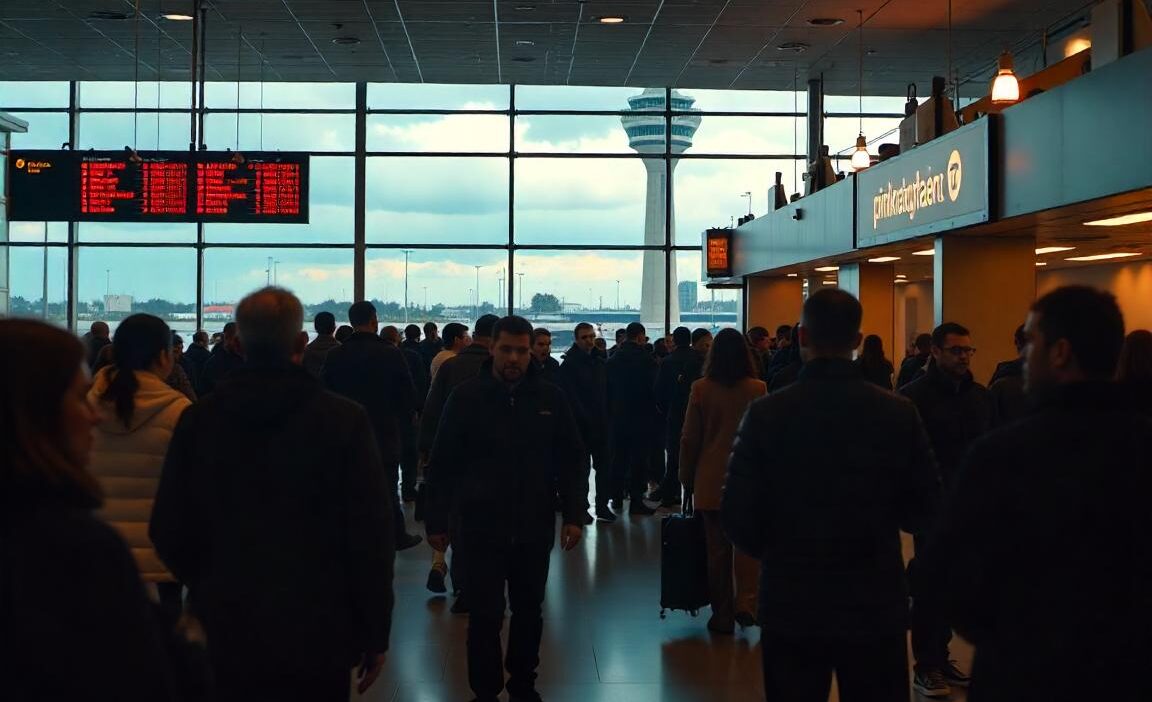Sunday, May 18, 2025

Travel chaos is no longer a distant fear—it’s unfolding in real time, right above us. The skies over Newark International Airport are thick with tension as the FAA slashes flights, igniting a chain reaction of flight disruptions and nationwide concern. What started as a tech failure has now escalated into a full-blown aviation crisis. And experts are sounding the alarm—loudly. Flight disruptions have become the new normal at Newark Liberty International Airport. The FAA, facing mounting pressure, has cut back flight schedules drastically. This travel chaos didn’t just appear overnight. It has been building, slowly, dangerously—until now, when every delayed flight feels like a warning.
Newark has been thrown into the spotlight as the FAA battles mounting issues with air traffic control. A recent tech failure crippled key systems, forcing the agency’s hand. The decision to slash flights was sudden, but the signs of a breakdown were long in the making. Experts, watching closely, are not surprised—but they are alarmed.
Travelers across the region are already feeling the sting of flight disruptions. Plans are collapsing. Connections are missed. Chaos rules the concourse. And with summer travel looming, the FAA’s move to slash Newark flights couldn’t come at a worse time. But what if this is only the beginning?
Experts are sounding the alarm because this isn’t just about Newark. It’s a glimpse into deeper issues infecting America’s air travel system. When one tech failure can shut down a major hub and trigger a flood of cancellations, something is broken. And while the FAA scrambles to patch the leaks, the travel chaos spreads.
Why did the FAA wait until now to act? Why slash flights so suddenly? What exactly triggered this collapse? These are the questions flying faster than jets through industry circles—and the answers point to system-wide vulnerabilities that extend far beyond Newark.
Meanwhile, tension is mounting. The travel industry, already stretched thin, faces another summer of unpredictability. Hotels are bracing for sudden cancellations. Airlines are racing to revise schedules. And travelers? They’re caught in the middle of a high-stakes gamble.
The skies above Newark are more than crowded—they’re chaotic. And with the FAA slashing flights to prevent a total breakdown, the ripple effect will touch cities across the U.S. From tech failures to flight disruptions, from travel chaos to expert warnings, this is a story that refuses to stay grounded.
Now, all eyes are on what happens next. Because if Newark can collapse, what’s stopping it from happening elsewhere? And why are so many experts sounding the alarm—right now?
America’s air travel system is hitting turbulence—and Newark Liberty International Airport sits at the epicenter. Following three days of high-level emergency meetings with airline executives, the Federal Aviation Administration (FAA) has unveiled a dramatic proposal: slash the number of flights landing at Newark. The reason? Mounting delays, traumatic controller outages, and outdated air traffic technology have turned one of the nation’s busiest airports into a chokepoint.
The FAA’s bold move is not just a local correction—it signals a nationwide reckoning for an overstretched aviation system buckling under pressure.
A System Over Capacity and Overstressed
Newark Airport, a critical hub in the northeast corridor, was designed to handle 77 operations per hour. Yet airlines routinely schedule far beyond that threshold, gambling on operational luck in an already-congested airspace. The result? Chronic delays, missed connections, and rising passenger outrage.
But the tipping point came with a catastrophic tech failure in late April. A sudden outage of both radar and radio systems at the Newark control tower grounded flights and shocked the system. Several controllers reportedly went on trauma leave. Since then, the airport’s performance has spiraled. Delays have surged. Travelers are fed up. The industry is on edge.
FAA’s Emergency Intervention
To prevent further chaos, the FAA is proposing strict arrival caps. Through June 15, the number of landings per hour will be throttled to just 28—a drastic reduction that slices deep into airline schedules. From June 16 to October 25, the cap will rise slightly to 34 per hour, still far below the airport’s designed capacity.
The decision isn’t arbitrary. One of Newark’s runways is currently undergoing major construction, reducing operational flexibility even further. By imposing flight limits, the FAA hopes to stabilize operations before summer travel peaks.
But the ripple effects will be national.
Travelers Caught in the Crossfire
Thousands of travelers could feel the squeeze. Fewer flights mean fewer options, higher ticket prices, and increased risk of missed connections. Families planning summer getaways, business travelers chasing tight schedules, and international tourists funneling through Newark will all face longer waits, fewer choices, and greater uncertainty.
The emotional toll is real. Delays lead to missed moments—reunions delayed, vacations shortened, and business deals disrupted. The FAA’s move may be about safety, but its human impact is impossible to ignore.
Airlines Scramble to Adapt
Major carriers are now forced to rethink their Newark strategies. United Airlines, which uses Newark as a key hub, faces the steepest cuts. With peak-hour scheduling trimmed back dramatically, United must reroute, reschedule, or cancel hundreds of flights.
Other carriers—Delta, JetBlue, American, Spirit, Alaska, and Allegiant—also face disruptions. Fleet allocation, staffing, and passenger rebooking efforts are now being recalibrated in real-time.
Airlines have invested billions in optimizing operations, but many have been operating beyond realistic airport limits. The FAA’s decision forces a long-overdue reset. Operational realism is replacing aspirational scheduling.
The Bigger Picture: A Broken Control System
At the heart of the crisis is America’s aging air traffic control infrastructure. Newark’s meltdown has exposed just how vulnerable the system is. One tech failure led to national consequences. The FAA acknowledges the need for urgent reforms—but the fixes will take years.
Already, the agency is working to add redundant telecommunications systems at Newark and has begun hiring new controllers. But such upgrades require time, funding, and bipartisan support—rare commodities in today’s political landscape.
Meanwhile, the Department of Transportation is pressing for broader modernization of the national air traffic system. But even the most optimistic forecasts suggest these enhancements won’t come online until the late 2020s.
Travel Industry on High Alert
Tourism boards, airport operators, and hotel chains are monitoring Newark’s situation closely. Disruptions at a major hub create cascading effects across the region. Delays at Newark can affect arrivals in Boston, departures in Atlanta, and hotel bookings in Miami.
In a competitive travel market already strained by inflation and global uncertainty, reliability matters more than ever. A single airport’s performance can make or break a traveler’s loyalty—or a destination’s reputation.
Newark’s recent ranking as the most on-time airport in the New York area now feels like a cruel irony. The reputational damage from these disruptions could take months to repair.
What Happens Next?
The FAA plans to finalize the new arrival caps by May 28. Until then, airlines, travelers, and tourism stakeholders are operating in limbo. The uncertainty is painful—but the cost of doing nothing is worse.
This moment could be a turning point for U.S. aviation. The FAA’s intervention, though abrupt, may finally force the system to confront its limits. Airlines must match ambition with realism. Airports must balance volume with safety. And travelers must brace for a summer of shifting schedules and strained skies.
But out of crisis comes clarity. Newark’s breakdown is a wake-up call for the entire travel ecosystem. And the message is clear: safety, stability, and sustainability can no longer be optional.
Tags: Atlanta, Boston, Chicago, East Coast, Los Angeles, Miami, New Jersey, New York, newark, United States, Washington D.C.




